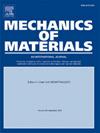考虑碳重分配的淬火马氏体和贝氏体相变的建模和有限元模拟
IF 3.4
3区 材料科学
Q2 MATERIALS SCIENCE, MULTIDISCIPLINARY
引用次数: 0
摘要
钢构件在加工过程中的组织控制是达到预期产品性能的关键因素。加工过程中微观结构演变的真实模拟可以通过减少对时间和成本密集的实验研究的需要,促进现有工艺的改进以及新工艺的设计。本文重点研究了高碳轴承钢100Cr6和100CrMnSi6-4部件淬火过程的建模和高级模拟,考虑了从奥氏体到马氏体和贝氏体的转变。由于碳含量的变化也改变了马氏体的起始温度,因此在无碳化物贝氏体形成过程中,奥氏体相的碳富集得到了特别的关注。在广泛使用的Koistinen-Marburger和Johnson-Mehl-Avrami-Kolmogorov模型的基础上,提出了一个新的模型,该模型明确考虑了残余奥氏体的碳含量及其对两种转变动力学的影响。该模型作为商业有限元软件Abaqus的用户材料实现。我们的源代码和校准数据可在https://github.com/InstituteOfMechanics/Phase_Trafos_Carbon_Repartitioning。本文章由计算机程序翻译,如有差异,请以英文原文为准。
Modelling and finite element simulation of martensite and bainite phase transformations during quenching under consideration of carbon repartitioning
Control of the microstructure of steel components during their processing is a crucial factor for reaching desired product properties. Realistic simulations of the microstructure evolution during processing can facilitate the improvement of existing processes as well as the design of new ones by reducing the need for time- and cost-intensive experimental investigations. This work focuses on the modelling and advanced simulation of quenching of components made of the high-carbon bearing steels 100Cr6 and 100CrMnSi6-4, during which transformations from austenite to martensite and bainite are considered. Special attention is given to the carbon-enrichment of the austenite phase during the formation of carbide-free bainite, since the change in carbon content also changes the martensite start temperature. A novel model based on the widely used Koistinen–Marburger and Johnson–Mehl–Avrami–Kolmogorov models is proposed, which explicitly takes into account the carbon contents of the remaining austenite and its influence on the kinetics of both transformations. The proposed model is implemented as a user material for the commercial finite element software Abaqus. Our source code and calibration data are available at https://github.com/InstituteOfMechanics/Phase_Trafos_Carbon_Repartitioning.
求助全文
通过发布文献求助,成功后即可免费获取论文全文。
去求助
来源期刊

Mechanics of Materials
工程技术-材料科学:综合
CiteScore
7.60
自引率
5.10%
发文量
243
审稿时长
46 days
期刊介绍:
Mechanics of Materials is a forum for original scientific research on the flow, fracture, and general constitutive behavior of geophysical, geotechnical and technological materials, with balanced coverage of advanced technological and natural materials, with balanced coverage of theoretical, experimental, and field investigations. Of special concern are macroscopic predictions based on microscopic models, identification of microscopic structures from limited overall macroscopic data, experimental and field results that lead to fundamental understanding of the behavior of materials, and coordinated experimental and analytical investigations that culminate in theories with predictive quality.
 求助内容:
求助内容: 应助结果提醒方式:
应助结果提醒方式:


